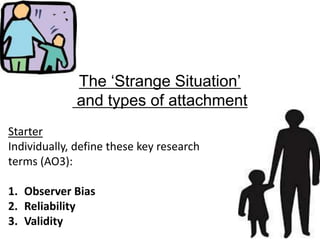
Strange situation & types of att
- 1. The ‘Strange Situation’ and types of attachment Starter Individually, define these key research terms (AO3): 1. Observer Bias 2. Reliability 3. Validity
- 2. We have looked at evolutionary and learning theory perspectives on how attachments are formed. We will now focus on the quality of and type of attachments that develop. Ainsworth’s caring hypothesis: The quality of an attachment depends largely on the kind of attention the infant has received from the primary caregiver. It makes sense for us to consider the quality of attachment as humans do not simply ‘imprint’; human relationships are heavily laden with emotion.
- 3. b) a) c) d) e)
- 4. L/O: to outline the ‘Strange Situation’ and the attachment types (AO1) Ainsworth and Bell (1970) set out to define the range of types of attachment. They believed that a child’s attachment to their mother could be observed in a child on separation and reunion with their mother. They set up the ‘Strange Situation’. What is the ‘Strange Situation’? - A standardised test - In a laboratory - A sequence of episodes of a few minutes each in which MOTHER, CHILD and STRANGER are introduced, separated and reunited. How did they measure attachment? - Researchers discreetly observe the child’s behaviour - Two aspects in particular: 1. reactions to separation and reunion 2. The level of exploration throughout the procedure
- 5. L/O: to outline the ‘Strange Situation’ and the attachment types (AO1) To begin to evaluate the research (AO2) The ‘Strange Situation’ Mary Ainsworth As you watch, consider: Reliability? Any Bias? Ethical Validity? Issues?
- 6. L/O: to outline the ‘Strange Situation’ and the attachment types (AO1) To begin to evaluate the research (AO2) So what did they find? Aim – to define the attachment types. Page 108 table of types of attachment. See ‘study in focus’ on page 109. 1. Read the observation record. 2. In pairs, try 6 (ai) identify the attachment type and (aii) justifying your answer. 3. Compare your answer with the mark scheme.
- 7. Past paper question 6(a) and (b). Read and take notes on the Study in Focus for the ‘Strange Situation’ and answer questions (page 69 study guide). Complete the remaining for self- study by Monday. (I will collect 6a- b then).
- 8. AO2 Applying our knowledge of types of attachment and evaluating the Strange Situation Tasks AO2 – decide which attachments types children A-G are displaying. AO2 – create two more example children with different attachment types. AO2 – guess another class member’s. AO1/AO2 – complete the Strange Situation outline and evaluate sheet using your notes / the textbook.